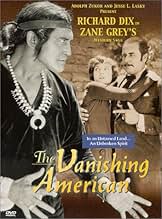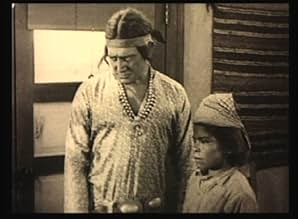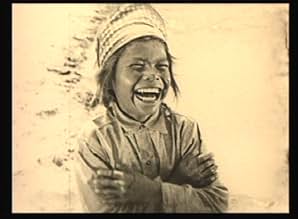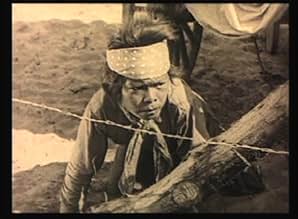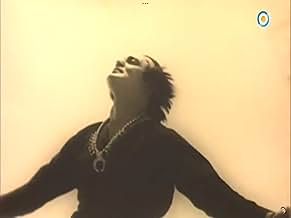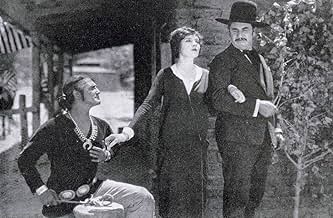Füge eine Handlung in deiner Sprache hinzuA Navajo tribe suffers mistreatment by an Indian-hating agent who steals their horses. When WWI breaks out, a teacher convinces the tribe leader that enlisting will lead to better treatment.A Navajo tribe suffers mistreatment by an Indian-hating agent who steals their horses. When WWI breaks out, a teacher convinces the tribe leader that enlisting will lead to better treatment.A Navajo tribe suffers mistreatment by an Indian-hating agent who steals their horses. When WWI breaks out, a teacher convinces the tribe leader that enlisting will lead to better treatment.
- Regie
- Drehbuch
- Hauptbesetzung
- Auszeichnungen
- 2 wins total
John Webb Dillion
- Naylor
- (as John Webb Dillon)
Gary Cooper
- Extra
- (Nicht genannt)
George Magrill
- The First Nophaie
- (Nicht genannt)
Empfohlene Bewertungen
After a few decades interval I re-watched "The Vanishing American" (1925) with Richard Dix, Lois Wilson, Noah Beery, Sr., Malcolm McGregor, Nocki, Charles Stevens, Bernard Siegel, Shannon Day, and others. I went in this time with the attitude that I'd watch as if it were 1925, not 2020, then assess the film from both ends, realizing that the finished assessment is still my own opinion and might differ radically from anyone else, or even everyone else. Overall, the picture, directed by George B. Seitz (known perhaps best as the director of most of the "Andy Hardy" series), is not just a Western taken from a Zane Grey novel, but closer to an attempt at an "epic" saga of a series of tribal leaders who are called Nophaie of what have become known as American Indians. The film begins before neolithic times, in a time where the geography is the beginning and the people follow into the geography. We then have a neolithic presence, then a sort of tribal presence, then the American Indian, then the arrival of Spanish invaders from down in the Mezo-American regions where they've already invaded, then the somewhat contemporaneous era of American Indians on a "reservation" mandated by whites who now rule the nation. Richard Dix is the current Nophaie of all the clans and/or tribes of the Western region plotted in the film. His instant nemesis is not the current white Indian agent of the area and the reservation, but rather his assistant, Noah Beery, Sr., an evil, money-grubbing, harassing, anti-Indian sort to whom viewers take an immediate dislike because of unbecoming behaviors at several turns. The local white teacher of all the Indian children is Lois Wilson. The plot runs as a typical Western would, except Wilson and Dix fall for each other, knowing that such is not going to be accepted; and the plot favors the Indian side over the white side which is shown to be duplicitous, sometimes out-and-out evil, and under a government that seems to talk out of both sides of its mouth, though follows its own path as it sees fit. And Manifest Destiny is behind all. I'll not give the entire plot, though we do follow the Indians through WWI and their return. I found the film as a 1925 vehicle very satisfying and well done. It manifests itself as any white produced film in America in 1925 would have done, though it gave the Indian far more a share than nearly any other film of the time would have dared, and the word "dared" is the operative one.
Now, shift gears and come up to 2020. It's interesting looking at the comments of viewers who have left criticisms of the film on the IMDb. Nearly all give the film from 8 out of 10 to 10 out of 10. EXCEPT 1. The one has the moniker of 'trujillotribe'. The Trujillo homesteads of Colorado were formed in the 1860s by Hispano Americans who came there when their lands were annexed from Mexico by America. The cultural differences in everything from farming to just being who each was caused conflicts that raged for decade after decade. The one exception on the IMDb as to rating "The Vanishing American" says the plot of the film is ridiculously false, and to quote the review, "Incorrect and disrespectful, regardless of the date released." It goes on in a vein of such feelings. I wondered when I finished watching this time if my liking the film wasn't based on my learning history in the 50s and 60s when Manifest Destiny was the theme of every history book. What does that entail? In a nutshell, it accepts - and that, too, is the operative word - it accepts the fact that white Europeans came to this land in 1492 and have with their doctrine of Christianity rightfully usurped all the land and driven out heathenism and savagery.
I accept that we've come to a point in our culture where accepting Manifest Destiny in its cultural overview of our history is not only outdated, but not 'history' in the proper sense of the word. It's very one-sided. But we've come to a time where the past is being dumped as utterly BAD. "The Vanishing American" actually is a very fine film in its regard to the American Indian of 1925. The film, considering when it was made, is lucky to have found a good audience with its theme. It had to have a Richard Dix as star, or few would have gone to see it. Also in the cast in a very prominent rôle is Charles Stevens. The name isn't known much today - a shame, as he was the grandson of Geronimo - and a terrific actor in his own right, plus a good tennis buddy of Douglas Fairbanks, Sr.! He could easily have essayed the rôle Richard Dix does, but would have found his audience not as wide as movie moguls would have needed to pay the bills. Interestingly, too, he plays the part of an Indian (and, of course, IS one) who has a thing for Gekin Yashi, NOT played by a Native American female, but by Shannon Day, a New York City born white woman who played several Indian and Mexican parts in her 29 film career!
Not to utterly belabor my thoughts, I enjoyed seeing this again, and I realize that I now live in a time that accepting white people playing native American parts is basically taboo, especially when the theme of the film is one where the whites are not necessarily the good guys. I found an interesting commentary by Richard Allen and Tom Holm which has this to say about the film: "...Were George Seitz and Zane Grey attempting to demonstrate that Christianity alone cannot save Native Americans? The film has the rudiments of an overriding theme of inevitable despair. In short, the fate of the cinematic Native American soldier is heroism for naught..."
I think the film should be watched, first, as a cinematographic masterpiece (Harry Perry and Charles Edgar Schoenbaum did the cinematography, much of which is borrowed again almost EXACTLY in "The Searchers" by John Ford), second, as an attempt by early Hollywood to exact a form of retribution for Manifest Destiny, whether it is appreciated a hundred years later or not, and, third, just because it plays very well without trying to belittle a race mercilessly and tells a good, if tragic, story.
Now, shift gears and come up to 2020. It's interesting looking at the comments of viewers who have left criticisms of the film on the IMDb. Nearly all give the film from 8 out of 10 to 10 out of 10. EXCEPT 1. The one has the moniker of 'trujillotribe'. The Trujillo homesteads of Colorado were formed in the 1860s by Hispano Americans who came there when their lands were annexed from Mexico by America. The cultural differences in everything from farming to just being who each was caused conflicts that raged for decade after decade. The one exception on the IMDb as to rating "The Vanishing American" says the plot of the film is ridiculously false, and to quote the review, "Incorrect and disrespectful, regardless of the date released." It goes on in a vein of such feelings. I wondered when I finished watching this time if my liking the film wasn't based on my learning history in the 50s and 60s when Manifest Destiny was the theme of every history book. What does that entail? In a nutshell, it accepts - and that, too, is the operative word - it accepts the fact that white Europeans came to this land in 1492 and have with their doctrine of Christianity rightfully usurped all the land and driven out heathenism and savagery.
I accept that we've come to a point in our culture where accepting Manifest Destiny in its cultural overview of our history is not only outdated, but not 'history' in the proper sense of the word. It's very one-sided. But we've come to a time where the past is being dumped as utterly BAD. "The Vanishing American" actually is a very fine film in its regard to the American Indian of 1925. The film, considering when it was made, is lucky to have found a good audience with its theme. It had to have a Richard Dix as star, or few would have gone to see it. Also in the cast in a very prominent rôle is Charles Stevens. The name isn't known much today - a shame, as he was the grandson of Geronimo - and a terrific actor in his own right, plus a good tennis buddy of Douglas Fairbanks, Sr.! He could easily have essayed the rôle Richard Dix does, but would have found his audience not as wide as movie moguls would have needed to pay the bills. Interestingly, too, he plays the part of an Indian (and, of course, IS one) who has a thing for Gekin Yashi, NOT played by a Native American female, but by Shannon Day, a New York City born white woman who played several Indian and Mexican parts in her 29 film career!
Not to utterly belabor my thoughts, I enjoyed seeing this again, and I realize that I now live in a time that accepting white people playing native American parts is basically taboo, especially when the theme of the film is one where the whites are not necessarily the good guys. I found an interesting commentary by Richard Allen and Tom Holm which has this to say about the film: "...Were George Seitz and Zane Grey attempting to demonstrate that Christianity alone cannot save Native Americans? The film has the rudiments of an overriding theme of inevitable despair. In short, the fate of the cinematic Native American soldier is heroism for naught..."
I think the film should be watched, first, as a cinematographic masterpiece (Harry Perry and Charles Edgar Schoenbaum did the cinematography, much of which is borrowed again almost EXACTLY in "The Searchers" by John Ford), second, as an attempt by early Hollywood to exact a form of retribution for Manifest Destiny, whether it is appreciated a hundred years later or not, and, third, just because it plays very well without trying to belittle a race mercilessly and tells a good, if tragic, story.
What a great surprise this movie is. This silent is a sleeper, a classic, wonderful film that does all the great things a soundless movie is capable of doing. Most importantly, this may be one of the most genuinely sympathetic movies ever about American Indians, because it does so without preaching, without portraying them as these mystical, magical humans, that, because they do things like use every piece of the buffalo they kill, are somehow better than all of us. You know the stereotype. It seems like Hollywood has never found a smart middle ground when it comes to portraying Indians: they are either savages or god-like innocents, but never normal. In The Vanishing American, the Indians are just regular people, largely pushed and pulled by fate and the inexorable spreading of the white way of life.
Here, we see the hurt inflicted on Indians in small ways, like a farm being taken by the Indian Agent from one man while he is away at war, or a tribe member taken to be a servant of the Agent, and dying in his service, and the pain this causes his survivors; we feel the sadness of the characters without being forced through a lecture.
At the same time, the movie is epic in nature, taking us through several millennia of time, and staging those massive battle scenes containing hundreds of extras that the silents, to me, do more effectively than the talkies ever could (perhaps it is the inherently haunting nature of all silent film that makes it seem so).
Richard Dix is acceptable as an Indian leader, but Noah Beery steals the show, playing one of the slimiest and sleaziest villains ever; he even kicks an Indian sitting at his office's doorstop, and not once, but twice, to get him out of the way!
This movie also takes patriotism very seriously; tears come to the school teacher's eyes when her class of young Indians says the Pledge of Allegiance. Religion, too, is treated with seriousness, as modern Hollywood never does; Christianity and the New Testament are held with reverence, but again, not too preachy.
I highly recommend this film to all silent film affectionados, as well as those interested to see a unique and oddly progressive film about Native Americans that was made in the 1920's.
Some small thoughts: (1) Early in the film, some Indians meet up with Spanish Conquistadors. The Indians are much more naked than we normally see them; No clothing at all up their hips: a little unnerving! (2) During an early battle scene, an invading tribe is attacking the cliff dwellers; the invaders climb tall ladders to reach the upper ledges. At one point, several ladders full of climbing invaders are seen; one of the ladders is pushed back, and a ladder full of invaders falls backwards, the men on it doomed to fall to their presumed deaths; if you look closely, though, the men on that ladder are clearly dummies.
(3) When Kit Carson's soldiers first hurry off to battle, the first carriage we see pulled by horses and supporting a cannon clearly loses a wheel as it flies down a hill. (4) Racial incongruity #1: The white Richard Dix, with make-up on to darken his features to make him look like an Indian, wearing a soldier's World War I uniform and fighting in the trenches. Racial incongruity #2: an Indian Chief introduced in a title, played by Bernard Siegle!
(5) When the Indian children in the school recite the Pledge of the Allegiance, they have their arms extended out in a manner that to modern eyes may seem like a fascist salute; is this how they used to do it? (6) At one point, Richard Dix is standing on one of the great stone arches of the American West, tossing feathers from his staff into the wind; the first feather he tosses is blown by the wind back to him, and sticks to his arm! He quickly swipes it away, though, and continues his scene.
Here, we see the hurt inflicted on Indians in small ways, like a farm being taken by the Indian Agent from one man while he is away at war, or a tribe member taken to be a servant of the Agent, and dying in his service, and the pain this causes his survivors; we feel the sadness of the characters without being forced through a lecture.
At the same time, the movie is epic in nature, taking us through several millennia of time, and staging those massive battle scenes containing hundreds of extras that the silents, to me, do more effectively than the talkies ever could (perhaps it is the inherently haunting nature of all silent film that makes it seem so).
Richard Dix is acceptable as an Indian leader, but Noah Beery steals the show, playing one of the slimiest and sleaziest villains ever; he even kicks an Indian sitting at his office's doorstop, and not once, but twice, to get him out of the way!
This movie also takes patriotism very seriously; tears come to the school teacher's eyes when her class of young Indians says the Pledge of Allegiance. Religion, too, is treated with seriousness, as modern Hollywood never does; Christianity and the New Testament are held with reverence, but again, not too preachy.
I highly recommend this film to all silent film affectionados, as well as those interested to see a unique and oddly progressive film about Native Americans that was made in the 1920's.
Some small thoughts: (1) Early in the film, some Indians meet up with Spanish Conquistadors. The Indians are much more naked than we normally see them; No clothing at all up their hips: a little unnerving! (2) During an early battle scene, an invading tribe is attacking the cliff dwellers; the invaders climb tall ladders to reach the upper ledges. At one point, several ladders full of climbing invaders are seen; one of the ladders is pushed back, and a ladder full of invaders falls backwards, the men on it doomed to fall to their presumed deaths; if you look closely, though, the men on that ladder are clearly dummies.
(3) When Kit Carson's soldiers first hurry off to battle, the first carriage we see pulled by horses and supporting a cannon clearly loses a wheel as it flies down a hill. (4) Racial incongruity #1: The white Richard Dix, with make-up on to darken his features to make him look like an Indian, wearing a soldier's World War I uniform and fighting in the trenches. Racial incongruity #2: an Indian Chief introduced in a title, played by Bernard Siegle!
(5) When the Indian children in the school recite the Pledge of the Allegiance, they have their arms extended out in a manner that to modern eyes may seem like a fascist salute; is this how they used to do it? (6) At one point, Richard Dix is standing on one of the great stone arches of the American West, tossing feathers from his staff into the wind; the first feather he tosses is blown by the wind back to him, and sticks to his arm! He quickly swipes it away, though, and continues his scene.
This excellent movie far transcends its own genre, with a resourceful and detailed production that makes for a worthy treatment of some thought-provoking themes. Adapted from the Zane Grey novel, it easily does justice to the interesting story, but it is much more than just a good melodrama. Ambitous in its scale, in its time-span, and in its themes, it puts the main story into a context that is as interesting to watch as it is challenging to many of the common conceptions about the history of the American West.
The main story features Richard Dix as a Native American on a reservation, who must contend with a wide range of persons from the 'white' races. Dix succeeds in making his character interesting, believable, and sympathetic. In particular, he does well with portraying the inner torment and longings of a perceptive and capable man who is forced by his environment to keep a lot of things inside.
The 'white' characters work well, and they are well-chosen so as to avoid a simplistic portrayal of those who went west. Noah Beery plays the villainous Booker effectively, making his ill intentions clear even when his character is at his most charming, yet at the same making it believable that such a reprehensible character could so often gain the upper hand. Lois Wilson is rather meek, but she works well with Dix in the relationship that is at the center of the story.
All of that would be good enough (and it doesn't even mention the beautiful scenery and photography in Monument Valley), but what makes the movie even better is that it is set in a broader context, which places the lengthy, heart-rending clash of cultures in the American West into a sweeping, far more comprehensive picture of the unending struggle of human cultures and societies as they rise and fall through the centuries. It balances a number of perspectives, and believably shows how complex the interplay between different cultures can be.
The lengthy prologue, often detailed and interesting in itself, paints a convincing and often harrowing picture of the nature of human societies in their struggles and rivalries through the ages. It adds a depth rarely seen to the eventual conflicts between the expanding USA and the Native American nations, and even if it were made today, it would be a bold statement that challenges stereotypes of all kinds. True indeed is the movie's theme that human cultures come and go, and that those standing strong today will someday pass away, with only the earth itself remaining always.
This movie surely deserves to be much better-known, for its top quality production of some often challenging material, its interesting story, and its themes that are worthy of careful and honest consideration. If it were filmed today, some of the details would probably be handled differently, but that is to a large degree a matter of style or fashion. The specific details are far less important than the movie's impressive depth and quality.
The main story features Richard Dix as a Native American on a reservation, who must contend with a wide range of persons from the 'white' races. Dix succeeds in making his character interesting, believable, and sympathetic. In particular, he does well with portraying the inner torment and longings of a perceptive and capable man who is forced by his environment to keep a lot of things inside.
The 'white' characters work well, and they are well-chosen so as to avoid a simplistic portrayal of those who went west. Noah Beery plays the villainous Booker effectively, making his ill intentions clear even when his character is at his most charming, yet at the same making it believable that such a reprehensible character could so often gain the upper hand. Lois Wilson is rather meek, but she works well with Dix in the relationship that is at the center of the story.
All of that would be good enough (and it doesn't even mention the beautiful scenery and photography in Monument Valley), but what makes the movie even better is that it is set in a broader context, which places the lengthy, heart-rending clash of cultures in the American West into a sweeping, far more comprehensive picture of the unending struggle of human cultures and societies as they rise and fall through the centuries. It balances a number of perspectives, and believably shows how complex the interplay between different cultures can be.
The lengthy prologue, often detailed and interesting in itself, paints a convincing and often harrowing picture of the nature of human societies in their struggles and rivalries through the ages. It adds a depth rarely seen to the eventual conflicts between the expanding USA and the Native American nations, and even if it were made today, it would be a bold statement that challenges stereotypes of all kinds. True indeed is the movie's theme that human cultures come and go, and that those standing strong today will someday pass away, with only the earth itself remaining always.
This movie surely deserves to be much better-known, for its top quality production of some often challenging material, its interesting story, and its themes that are worthy of careful and honest consideration. If it were filmed today, some of the details would probably be handled differently, but that is to a large degree a matter of style or fashion. The specific details are far less important than the movie's impressive depth and quality.
Okay, it is very possible to quibble with this film if you are too wrapped up in political correctness. Sure, it's a real shame that the film starred the white actor, Richard Dix, in dark paint as the Indian lead in the film. However, having White actors play Indians was pretty much the rule up to the 1960s, so I could easily overlook this. And, the beginning of the film can seem a tad preachy and irrelevant (though I liked it, Leonard Maltin's Guide knocked this section of the film). However, given that the film was made in the rather racist 1920s (when the KKK was on the rise and one of the strongest political forces in America), it is a truly amazing and transcendent film that definitely deserves to be seen and appreciated.
Unlike the typical cowboy movie of the day, the Indians in the film are neither blood-thirsty savages nor are they simple-minded. Instead, the are uniformly shown as decent Americans who want a fair shake and a part of the American Dream. In fact, their desire to become TRUE Americans and their love of their country make this a great patriotic film. While based on all the horrible injustices they received in the film, their fundamental decency seems amazing.
In addition to excellent acting, writing and direction, special attention must be focused on the spectacular and breathtaking cinematography--especially towards the beginning of the film. The scenes of the Grand Canyon are among the most beautiful ever filmed during the silent era and are in many ways reminiscent of moving versions of Ansel Adams photos. The film is a true work of art.
Unlike the typical cowboy movie of the day, the Indians in the film are neither blood-thirsty savages nor are they simple-minded. Instead, the are uniformly shown as decent Americans who want a fair shake and a part of the American Dream. In fact, their desire to become TRUE Americans and their love of their country make this a great patriotic film. While based on all the horrible injustices they received in the film, their fundamental decency seems amazing.
In addition to excellent acting, writing and direction, special attention must be focused on the spectacular and breathtaking cinematography--especially towards the beginning of the film. The scenes of the Grand Canyon are among the most beautiful ever filmed during the silent era and are in many ways reminiscent of moving versions of Ansel Adams photos. The film is a true work of art.
A great epic. The proof that George B. Seitz was a great director. A very fine cast. Dix and Wilson are outstanding. The story takes you from the time of the dinosaurs to our days in a very convincing way.
Wusstest du schon
- WissenswertesThe legend that John Ford "discovered" Monument Valley (or John Wayne did and Ford took credit for it), or Harry Goulding (the trading post owner there) introduced Ford to this unique location in 1938 for Höllenfahrt nach Santa Fé (1939), is disproved by the fact that this movie was filmed there in 1925.
- VerbindungenFeatured in The House That Shadows Built (1931)
Top-Auswahl
Melde dich zum Bewerten an und greife auf die Watchlist für personalisierte Empfehlungen zu.
Details
Box Office
- Bruttoertrag in den USA und Kanada
- 286.809 $
- Laufzeit
- 1 Std. 50 Min.(110 min)
- Sound-Mix
- Seitenverhältnis
- 1.33 : 1
Zu dieser Seite beitragen
Bearbeitung vorschlagen oder fehlenden Inhalt hinzufügen

